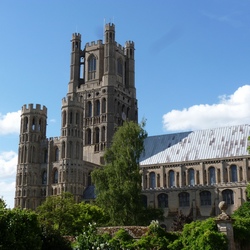

Worship Project
Ely Cathedral Rewiring
- Location:
- Ely
- Client:
- Dean And Chapter Of The Cathedral
- Architect:
- Purcell
- Cost:
- £220,000
The Cathedral
Ely Cathedral was founded in AD 672 by St Etheldreda as an Abbey Church. The oldest parts of the present building date back to 1083 and were constructed in a monumental Romanesque style. The Galilee Porch, Lady Chapel and Choir were rebuilt in an exuberant Decorated Gothic. Along with the West Tower, the central Octagonal tower, with lantern above, provides a unique exterior landmark that dominates the surrounding landscape.
In the puritan 16th and 17th centuries, the Cathedral became more and more dilapidated, but was saved by a series of restorations in the following years. Among the work was that of George Gilbert Scott, who oversaw a series of repairs in the mid-19th century, his first cathedral commission. The most recent restorations took place between 1986 and 2000 under successive Surveyors to the Fabric, initially Peter Miller and later Jane Kennedy. In 2000 a Processional Way was built, restoring the direct link between the north choir aisle and the Lady Chapel.
Lighting
The present lighting scheme by Graham Phoenix was designed and installed two decades ago. By 2015, serious problems with the state of the electrical cables became evident. Mineral-insulated copper clad cable had been used, but, as was common at the time, bare cable had been installed. Corrosion had caused the outer copper covering of the cable to split. Thanks to a grant from the First World War Centenary Cathedral Repair Fund, it has now been possible to replace the failed and failing cable.
Discreet Installation
The Cathedral has been the backdrop in many film productions, including the 2015 version of Macbeth starring Michael Fassbender and Marion Cotillard. Ensuring that the modern electrical installation does not obtrude and spoil the enjoyment of the Cathedral by its many visitors and film-goers was essential.
Cable
Mineral-insulated cable, if correctly used, is robust and can be run without additional support or protection, so it was specified again, using a protective sheath. In order to hide the cable as much as possible, a stone-coloured sheath was specified. This matches the cathedral masonry, stone from Barnack, bought from quarries belonging to Peterborough Abbey for 8000 eels a year, with decorative elements carved from Purbeck marble and local clunch. Cable was carefully concealed in the angles of the masonry, above stone ledges and behind the timber ceiling of the Processional Way, to ensure that it is barely noticeable to most modern visitors.